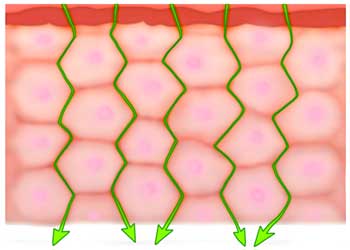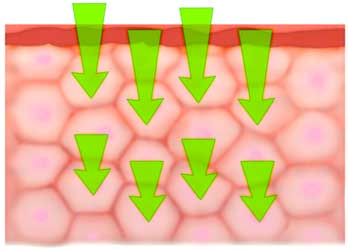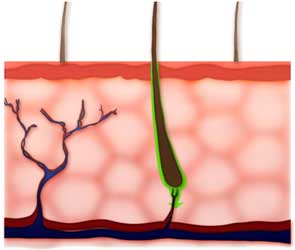From the CDC (Centers for Disease Control & Prevention) article:
Skin Exposures & Effects
"It is estimated that more than 13 million workers in the United States are potentially exposed to chemicals that can be absorbed through the skin"
Dermal Absorption
Dermal absorption is the transport of a chemical from the outer surface of the skin both into the skin and into the body. Studies show that absorption of chemicals through the skin can occur without being noticed by the worker, and in some cases, may represent the most significant exposure pathway. Many commonly used chemicals in the workplace could potentially result in systemic toxicity if they penetrate through the skin (i.e. pesticides, organic solvents). These chemicals enter the blood stream and cause health problems away from the site of entry.
The rate of dermal absorption depends largely on the outer layer of the skin called the
stratum corneum (SC)
. The SC serves an important barrier function by keeping molecules from passing into and out of the skin, thus protecting the lower layers of skin. The extent of absorption is dependent on the following factors:
- Skin integrity (damaged vs. intact)
- Location of exposure (thickness and water content of stratum corneum; skin temperature)
- Physical and chemical properties of the hazardous substance
- Concentration of a chemical on the skin surface
- Duration of exposure
- The surface area of skin exposed to a hazardous substance
Research has revealed that skin absorption occurs via diffusion, the process whereby molecules spread from areas of high concentration to areas of low concentration. Three mechanisms by which chemicals diffuse into the skin have been proposed:
- Intercellular lipid pathway (Figure 1)
- Transcellular permeation (Figure 2)
- Through the appendages (Figure 3)
Figure 1: Intercellular lipid pathway
As shown in Figure 1, the stratum corneum consists of cells known as corneocytes. The spaces between the corneocytes are filled with substances such as fats, oils, or waxes known as lipids. Some chemicals can penetrate through these lipid-filled intercellular spaces through diffusion.
Figure 2: Transcellular permeation
As shown in Figure 2, another pathway for chemicals to be absorbed into and through the skin is transcellular, or cell-to-cell, permeation whereby molecules diffuse directly through the corneocytes.
Figure 3: Through the appendages (hair follicles, glands)
As shown in Figure 3, the third pathway for diffusion of chemicals into and through the skin is skin appendages (i.e., hair follicles and glands). This pathway is usually insignificant because the surface area of the appendages is very small compared to the total skin area. However, very slowly permeating chemicals may employ this pathway during the initial stage of absorption.








 , and good post up there!
, and good post up there! Cheers!
Cheers!